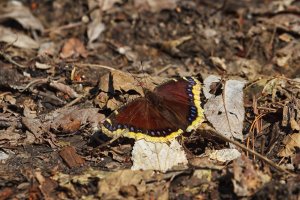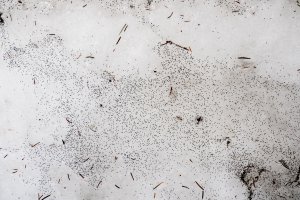Wild Wednesday: Where do Insects Go in Winter
February 8, 2023
By: Erin Parker, Interpretive Services Supervisor
Winter in our Metroparks means many things to nature-lovers and outdoor recreation enthusiasts: American tree sparrows and dark-eyed juncos at our bird feeders and hopes of cross-country skiing with the arrival of snow. We can find tracks of a variety of mammals, hear bird calls, and even find nesting owls. But one thing that is mostly absent from our winter outdoor adventures are the insects. Where do they go in winter?
Many strategies for surviving winter
Arthropods, the group of invertebrates that includes everything from spiders to mosquitos, have a variety of strategies for making it through the cold temperatures of winter. Most of these organisms cannot maintain a body temperature that is much different than the outside conditions, and so winter weather provides a host of challenges.
One strategy is that the adults reproduce, leaving eggs or larvae behind to carry on their genetic material, and die as winter approaches. Eggs, larvae, and protective cases such as cocoons allow insects to survive in a paused growth state while snow falls and temperatures drop. As things warm up in the spring, these life stages can hatch out and take advantage of new plant growth and food sources.
Some insects migrate, such as the monarch butterfly that makes a lengthy journey to mid-Mexico. The adult butterflies overwinter in oyamel fir forests, where weather conditions stay cool and damp and the insects don’t really feed or move much until spring. While these specific long-distance travelers won’t make it all the way back to Michigan themselves, they’ll move northward and lay their eggs in the Gulf Coast in early spring. While much less well known than the monarch migration, some dragonflies, such as the Green Darner migrate from Michigan as far south as the Gulf Coast! Much like the monarch, these adults won’t be the same individuals that return to Michigan in the summer. Instead, they lay their eggs in ponds in the south, starting the annual cycle of south-and-northward journeys again!
Other dragonflies overwinter under the water in their aquatic larval form, where some don’t climb out of the water to complete their metamorphosis into winged adults for a full two years.
A few insects overwinter in Michigan as adults. The Mourning Cloak butterfly, for example, is often the first butterfly to appear in the early spring, often flying on warm and sunny days before the snow has completely melted from their woodland habitats. They spend their winters tucked into cracks in tree bark, in the leaf litter, or rock crevices. Mourning Cloak, Eastern Comma, and Question Mark butterflies all feed on tree sap, manure or animal droppings and other non-nectar sources. This allows them to feed long before the majority of our spring flowers are in bloom! These are also some of the longest-lived butterflies, though they spend many winter months in the insect version of hibernation (called torpor), only waking on warm and sunny days.
 A few species of butterflies, such as this Mourning Cloak (Nymphalis antiopa), actually overwinter as adults- one important reason to leave leaf litter over the winter and not be too eager to clean up lawns and landscapes in early spring!
A few species of butterflies, such as this Mourning Cloak (Nymphalis antiopa), actually overwinter as adults- one important reason to leave leaf litter over the winter and not be too eager to clean up lawns and landscapes in early spring!
Luckily for the songbirds that remain active all winter, caterpillars can also be found waiting for spring to warm them and end their season of torpor. While some of these, such as the wooly bear caterpillar, are familiar to us, many of them are tiny “inchworms” that look like pieces of tree bark, stems, or branches. Sharp-eyed black-capped chickadees and others consume them from the tips of tree branches, pinecones, and bark crevices. Those that survive, warm up and hatch out in the springtime.
One of the common strategies that allows insects to survive the winter is to be in the soil, tree bark or other site as an egg. While some may be consumed by hungry animals, providing an important source of protein, many make it through to emerge in the spring,
Arthropod hatching out can be triggered by warming temperatures of air or soil, spring rains allowing things such as fairy shrimp to emerge into woodland vernal pools, and even the change in daylight length that heralds the return of migratory birds; just in time to feast on the newly emerged insects.
Active in winter
Finally, there are a few insects that can be found on sunny days even in the snowiest days of winter. Organisms like springtails, often called snow fleas for their tiny size and active behavior, can be found ringing tree trunks in the snow.
 Snow fleas (Hypogastrura nivicola) gather in the snow on warm days to search for their favorite foods like decaying and decomposing plant matter.
Snow fleas (Hypogastrura nivicola) gather in the snow on warm days to search for their favorite foods like decaying and decomposing plant matter.
While we may be grateful for our wintery break from insects, our wildlife food chains depend on them and the many strategies that allow insects to survive the cold months allow other animals to thrive.
Can you find any evidence of insects on your next winter adventure?
